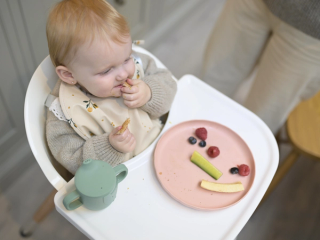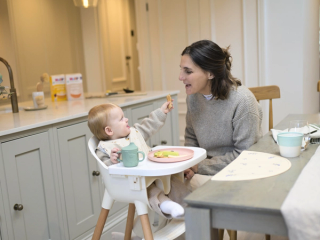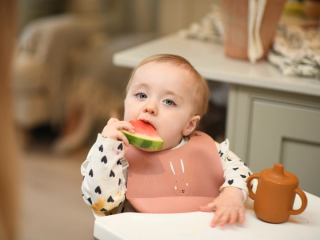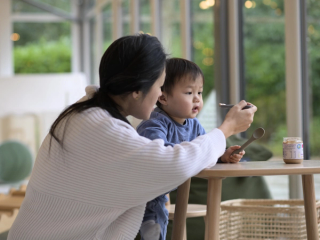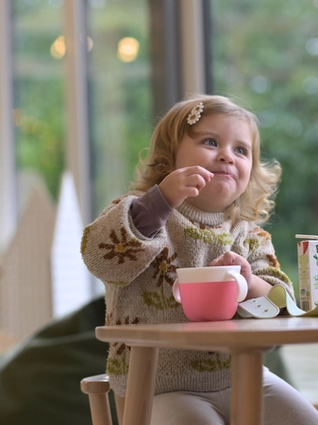
- Home
- Advice Hub
- Toddler
- Toddler Feeding
- Creating A Balanced Diet For Toddlers
How to create a balanced diet for toddlers
Learn why a balanced diet for toddlers is important and the types of foods your toddler should be eating.
Eating a balanced diet can sometimes feel difficult for yourself, but getting toddlers to eat healthily can feel like an entirely different challenge. It’s a struggle that leaves many parents feeling like it’s mission impossible!
But it doesn’t need to be, with some simple planning and a few practical tips, you'll get the hang of it in no time. This handy guide to feeding toddlers goes through the most important parts of feeding your toddler and will set you on the right path.
What is a balanced diet for toddlers?
A balanced diet for your toddler is one that includes a mix of all the food groups and meets the nutritional requirements for 1-2 year olds; which are different from the needs of an adult.
Why is a toddler’s diet different?
Your toddler’s diet will look different to yours because their requirements are different. Toddlers need more calories but less protein (per kilo of weight) than adults. They should also have less salt and fibre too. As they have small stomachs but high energy needs; smaller more regular eating opportunities across the day tends to work well.
What should my toddler’s diet consist of?
Toddlerhood is an important time to help establish good eating habits and prevent picky eating in the future. By offering a wide variety of foods, you expose your child to different tastes and textures, which can help them develop a more adventurous palate as they grow. So, variety and thinking about specific foods is important, but so is the way you offer foods. Read more about helping your toddler to develop a healthy relationship with food here.
But from a nutrition point of view; what should a balanced diet for a toddler look like? Let’s break it down into key food groups:
Protein is important for growth, but don’t worry it’s very unusual for toddlers to be lacking in protein. Most are still drinking some milk, and you can include foods like meat, fish, eggs, beans, yoghurt, nut butters, and lentils in your toddler's meals.
Carbohydrates provide the energy your child needs to stay active. Good sources include whole grains like oats, cereals, rice, yam, pasta, potatoes, chapattis, and bread. These foods should be given every time your toddler has a meal or snack.
Fruits and Vegetables are packed with vitamins, minerals, and fibre. In general in the UK, beyond infancy our fruit and vegetable intakes tend to be lower than recommended. Aim to give a fruit or vegetable at each meal or snack so that your little one gets used to eating them. After the age of two you should aim for at least five small portions of fruit and veg daily. Try offering a variety of colours, as each colour provides different nutrients; green vegetables like broccoli are high in iron, while orange vegetables like carrots are rich in vitamin A. Don’t get too hung up on individual nutrients though, just aim to eat the rainbow across the week if you can!
Dairy products are an excellent source of calcium, which is crucial for building strong bones and teeth. Aim for 2-3 portions a day of milk, cheese, and yoghurt in your toddler’s meals. If your child has a milk allergy, there are plenty of fortified dairy alternatives available, like soya or oat milk that you can use instead. Don’t overdo it though, milk is important but giving more than around 400ml of milk a day may reduce appetite for other foods and high intakes of milk may lead to decreased iron levels.
Omega 3 fats: Children need to eat these healthy fats, as they are essential for brain and eye development. Oily fish (such as salmon, mackerel or trout), flaxseeds and rapeseed oils are all great additions to the diet.
Drinks: Toddlers should drink plenty of fluids throughout the day. Water is the best option, but milk (300ml a day) is also important for calcium intake. Limit sugary drinks like juice, and try to avoid fizzy drinks and drinks with sweeteners altogether. If you offer drinks on waking and going to bed, the three meals and at two snack times that’s seven drinks a day which should be plenty.
What about things you need to limit?
Sugars are a source of energy for children, but too much can lead to problems such as tooth decay and excess weight gain. The sugar that is naturally occurring in milk, fruit and vegetables are all fine to consume freely; but avoid giving your toddler too many added or free sugars (such as biscuits, cakes or sweets).
There’s a balance to be found between keeping sugar low and not making it forbidden which will increase desirability and put it on a pedestal. Aim to give small portions of sugary foods alongside other foods; this helps to protect your little one’s teeth and helps to normalise these foods and make them less exciting.
Salt: Although toddlers can safely eat a bit more salt than babies; the recommended amount increases from less than 1g under 1 year, to no more than 2g per day, it is still important to keep levels low to avoid putting strain on kidneys or developing a taste for salty foods early on. To keep salt low avoid using too many ready-made meals, flavourings and stocks in cooking. Instead, focus on fresh, whole foods and let your toddler’s taste buds develop naturally without added salt.
Ideas for healthy toddler meals
Ask any parent and they’ll tell you that one of the most relentless everyday tasks (other than the piles of washing) is deciding what everyone is going to eat five times a day. That’s 1825 times you have to think what to feed your child every year. So, to get you started and to show you that a balanced diet for kids doesn’t need to be complicated here are some examples that you could add to your toddler meal plan. Remember, where you can, batch cooking and freezing small portions for you and your child to eat will make life easier in the long run.
Another thing to consider with all of these meals and snacks is that a healthy diet is the food that is eaten across several days, weeks and months, not one individual meal. Try not to stress too much if some meals don’t go to plan and your child doesn’t eat everything available to them. Finish up, move on and at the next meal different types of foods will probably be eaten that offer something different nutritionally.
Breakfast:
- Porridge topped with mashed banana or a handful of berries.
- Scrambled eggs on toast with a side of roasted tomatoes.
- Fortified cereal served with milk and some chia seeds sprinkled on top
Lunch:
- Mini sandwiches filled with hummus andgrated carrot, mashed avocado, chicken slices or cream cheese served with sticks of cucumber and pepper.
- Vegetable omelette with grated cheese and a side of fruit slices, such as apple or pear.
- Homemade soup like tomato or lentil with bread for dipping.
Dinner:
- Grilled salmon or white fish with mashed sweet potato and broccoli.
- Spaghetti Bolognese made with added grated carrot and courgette, served with wholewheat spaghetti and topped with cheese
- Jacket potato with cheese and beans and some slices of cucumber
Snacks:
- Crumpet with peanut butter and sliced banana
- Crackers with cream cheese and sliced cucumber
- Breadsticks with slices of ham and cherry tomatoes
Balanced nutrition to help develop your toddler’s growth
Hopefully you can see, that feeding a toddler doesn’t have to be complicated! By providing a balanced diet packed with nutrients, you’ll help your little one grow, develop, and thrive. Remember, every toddler is different, and it’s normal for their appetite to vary from day to day. The more relaxed you can make mealtimes the better they are likely to work out.
If you’re ever concerned about your child’s eating habits or nutritional intake, and you feel that it’s too difficult to change things on your own; it’s best to consult a healthcare professional such as your health visitor, GP or a dietitian.
